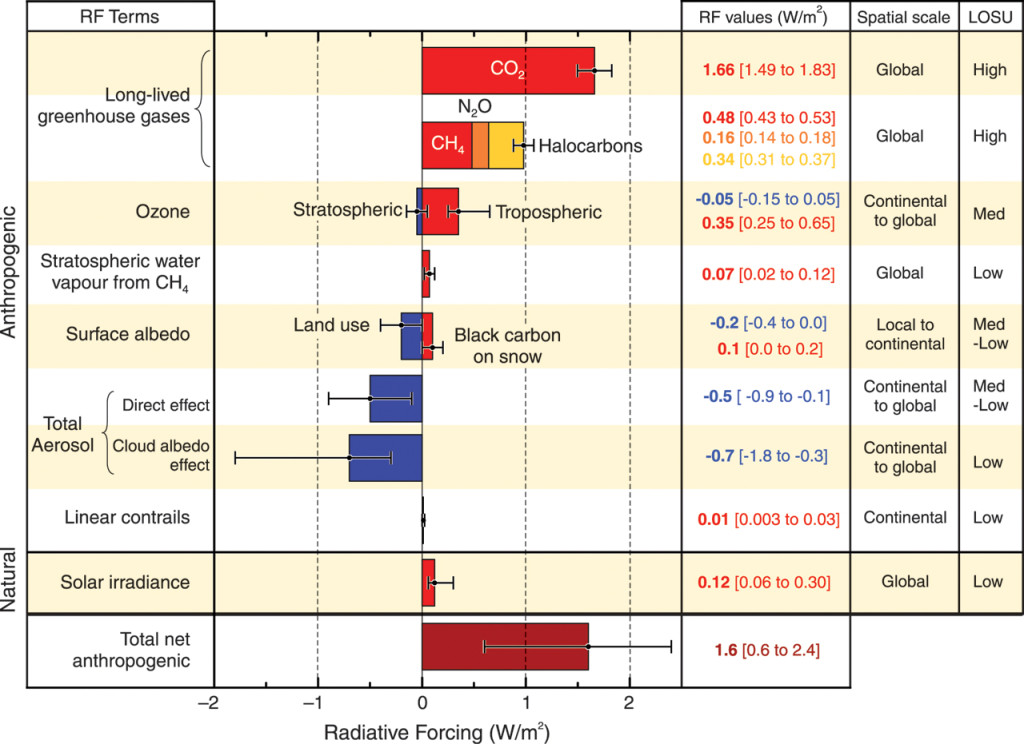 Above is a figure (it is figure 2.4 of the summary) of the International Panel on Climate Change report of 2007, i.e., the consensus report by scientists on how we are affecting the Earth’s climate. The figure is a bit crowded so ignore the details. Just start with the top bar — this shows the effect of CO2 on what they call at the bottom ‘radiative forcing’. Note that radiative forcing has units of Watts per square metre. A Watt is 1 Joule per second, so 1 Watt per square metre is 1 Joule of heat energy per second per square metre of the Earth’s surface – it is kind of a unit for global warming per unit time per unit area.
Above is a figure (it is figure 2.4 of the summary) of the International Panel on Climate Change report of 2007, i.e., the consensus report by scientists on how we are affecting the Earth’s climate. The figure is a bit crowded so ignore the details. Just start with the top bar — this shows the effect of CO2 on what they call at the bottom ‘radiative forcing’. Note that radiative forcing has units of Watts per square metre. A Watt is 1 Joule per second, so 1 Watt per square metre is 1 Joule of heat energy per second per square metre of the Earth’s surface – it is kind of a unit for global warming per unit time per unit area.
The CO2 bar is the biggest one, as you should expect, it is the one people always talk about. But it is not the only cause of warming, there are others. I don’t want to go through all of them, but look at the total aerosol one — the last but one of the anthropogenic (i.e., man-made) effects. In particular, look at the whopping great error bars on this bar. All the estimates of the effects have error bars — the scientists who wrote the report are very careful scientists who of course estimate and use error bars, unlike many of the climate-change deniers many of whom don’t know the difference between an error bar and a crow bar.
This error bar mostly comes from the error bar in the ‘cloud albedo effect’. Albedo is just how much light, here sunlight, is reflected, here back into space. The basic point is simple: clouds are white and so have a high albedo, so the fraction of the Earth that is covered with cloud reflects a lot of the sunlight that fall on i straight back into space. This cools the Earth.
So if we as a species do stuff that makes clouds, we cool the Earth, but if we do stuff that inhibits their formation, we heat the Earth.
Clouds are complex, ephemeral things that form, then literally evaporate into thin air. They are made up of tiny water droplets or ice crystals, or a mixture of both. And as it happens pretty much all these droplets and crystals start to form on aerosol particles — an aerosol particle is just a small particle in the atmosphere, small enough to be blown around on the winds without falling to earth.
So, the small particles we produce, such as the soot from burning hydrocarbons, can in principle help clouds form by helping the droplets form, and so make the Earth look whiter, and hence cool it. The snag is (apart from soot particles being not great for us) that clouds are complex ever-changing things, so estimating the effect of the aerosol particles we are producing is tricky. Hence the large error bars.
So, as far as global warming is concerned, clouds may have a silver lining, but we can’t be sure.
